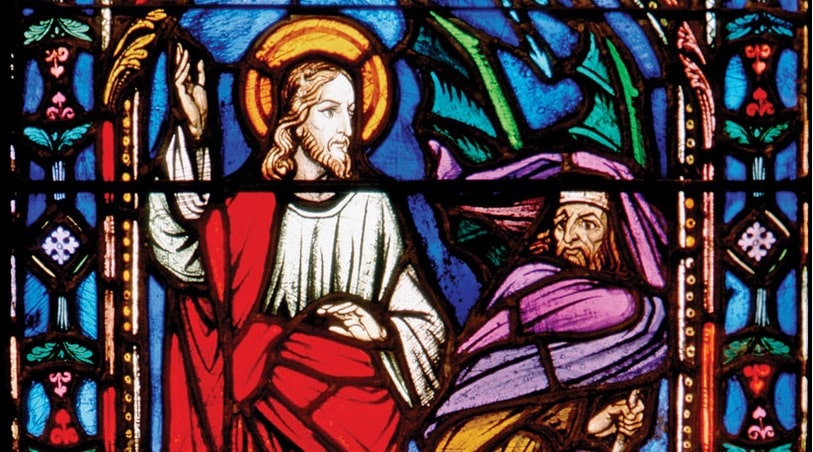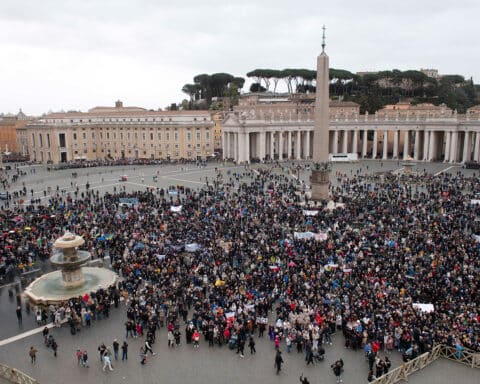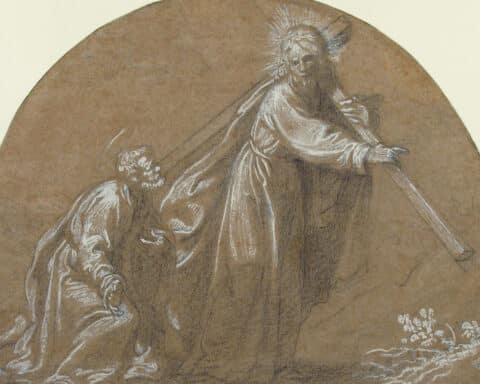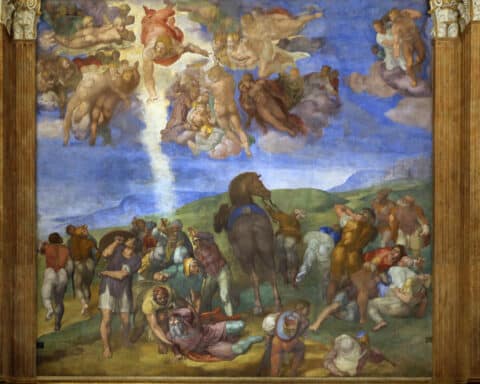Editor’s note: Portions of this story are graphic and may be difficult to read.
David Arias is an exemplary leader among Southern California Catholics. Working in the Hispanic community, Arias has been involved in many evangelization efforts in the Diocese of San Bernardino and Archdiocese of Los Angeles, including with his primary apostolate, Prophets of Hope, which trains Church leaders in the presentation and defense of the Catholic faith. When Arias shares the story of his journey of faith, however, listeners are stunned to learn that 20 years ago not only was he an inactive Catholic, but a member of a Satanic cult.
“The Lord is powerful,” he said. “Little by little, with his grace, I was able to change.”
A time of horror
Arias, 40, was born in Mexico City. At age 16, he moved to California with his family, settling in the San Fernando Valley region of Los Angeles. He was a “troublemaker,” he said, and conflict with his family was common. He described his family as “culturally Catholic.”
Friends in high school — and he noted he used the term “friends” loosely — introduced him to the Ouija board, which participants use to contact spirits (many Catholic leaders condemn the Ouija board as an introduction to the demonic). Furthermore, he was invited to play it in a cemetery.
He received invitations to “underground” parties, which involved promiscuity and extensive drug and alcohol use. He was then invited to get involved in the “Satan church.”
Arias defines a Satanist as “one who rejects, hates and curses God.” His particular group had about 80 members, including several “priests” who would lead activities. Rituals and specific activities vary from group to group. His group gathered monthly for a “black Mass,” a mockery of the Catholic Mass.
Arias said his group kept a low profile, as they were involved in extensive criminal activity, including rape, drug and alcohol abuse and murder. He said there were three steps involved in one’s entrance into the cult 1) beginners observed rituals, 2) the more experienced participated in sacrifices of animals (such as rats and cats), which included drinking their blood and pronouncing curses on others, and 3) the finalists sacrificed humans. Those murdered could be runaway teens, or the babies of women in the group who got pregnant.
Arias said his group included all ages (at 16, he was among the youngest) and ethnicities. Many were “gothic,” people who dress in black, and color their hair, lips and around their eyes black. Others appeared perfectly respectable and worked as doctors, lawyers and engineers.
Members were always on the lookout for new recruits, he said. Of particular interest were teen girls, as they could be impregnated and their babies sacrificed. He said, “Teenagers are looking for something and are open to experimentation. It was easy to get them in and then hooked on sex or drugs.”
The group was careful to avoid the police and threatened to kill any member who went public with his experiences.
A better way
| On the Devil |
|---|
|
“The doctrine of original sin, closely connected with that of redemption by Christ, provides lucid discernment of man’s situation and activity in the world. By our first parents’ sin, the devil has acquired a certain domination over man, even though man remains free. Original sin entails ‘captivity under the power of him who thenceforth had the power of death, that is, the devil.’ Ignorance of the fact that man has a wounded nature inclined to evil gives rise to serious errors in the areas of education, politics, social actions and morals. The consequences of original sin and of all men’s personal sins put the world as a whole in the sinful condition aptly described in St. John’s expression, ‘the sin of the world.’ This expression can also refer to the negative influence exerted on people by communal situations and social structures that are the fruit of men’s sins. This dramatic situation of ‘the whole world [which] is in the power of the evil one’ makes man’s life a battle: ‘The whole of man’s history has been the story of dour combat with the powers of evil, stretching, so our Lord tells us, from the very dawn of history until the last day. Finding himself in the midst of the battlefield man has to struggle to do what is right, and it is at great cost to himself, and aided by God’s grace, that he succeeds in achieving his own inner integrity.’ |
Arias was involved with the group for four years. As Arias was alienated from his family, they had no idea he was part of a cult. If he were to dress oddly, “my family thought that was just the fashion.”
However, Arias “felt empty” inside. He walked by a church one day and, looking at its cross, offered a challenge to God: “Can you offer me something better than Satan?”
Walking away from the group would prove difficult, he said, “but the Lord started working in me and changed everything.”
Arias went back to church, married his wife Maria, and, today, has three children. He moved from San Fernando to San Bernardino — away from his former associates in the Satanic cult — and today works in quality control for a large company. He uses his free time to teach others about the Catholic faith, as well as warn of dangerous influences in the culture.
He said, “Parents need to be aware of what their children are doing. Today, children have easy access to many things that are harmful.”
Demonic influences
After four years in a cult, Arias sees many examples of the demonic influencing society. Regarding abortion, for example, he said, “The evil one wants human sacrifices, and abortions are sacrifices.”
He noted that one member of his cult was an abortionist.
Some music popular among teens is Satanic, he noted, which can help lead young listeners away from God. And, although Halloween is a popular holiday among millions of Americans, Arias is no fan. He says it is a popular day for activity among Satanic cults.
One recent phenomenon that reminded him of the influence of the demonic, he said, is the so-called “knockout game,” in which inner city black teens sucker punch unsuspecting whites as they walk by. He said, “Who is inspiring this hatred? A normal human being wouldn’t do this; the influence has to be coming from somewhere.”
Spiritual help
In his own battle against Satan, Arias said, he regularly goes to Mass and receives holy Communion (even Satanists recognize the Body of Christ, he noted, and like to steal hosts so they can desecrate them during Black Masses). He makes regular use of confession and a variety of personal devotions, particularly the Rosary. He noted, “The Rosary is powerful. When someone is praying the Rosary, evil gets upset!”
He also wants his fellow Catholics to take their faith seriously, so he leads weekly education classes through Prophets of Hope at his parish. He said, “We need to know what we believe and stay in communion with Christ.”
Father Martin Madero, associate pastor at St. Genevieve Church in Panorama City in California, has been a longtime friend of Arias and has offered him counsel in his apostolates. Arias has become a role model in the Catholic community, he said: “He may have been a Satanist at one time, but he’s converted. He really lives his Catholic faith, and so does his family. He’s a leader in the community.”
Arias is not concerned about his safety speaking out publicly against Satanism and sharing his personal experiences. He lives in a different community, he noted, and his involvement ceased 20 years ago.
And, most importantly, he said, “The Lord is with me. With him, I have nothing to fear.”





